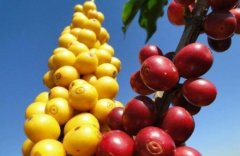The History and present situation of Coffee cultivation in China
I. World Coffee cultivation History
Coffee is native to the tropics of northern and central Africa. It has been cultivated for more than 2000 years, and the Arabs began to plant it in 525 BC. At first, coffee beans were only used for chewing. In 890 AD, Arab merchants brought coffee to Yemen and made it into a drink for the first time. By the 13th century, Arabs had the habit of stir-frying coffee, but coffee was not cultivated on a large scale until after the 15th century. after the 18th century, coffee has been widely distributed in the tropics and subtropics of Europe, Asia, Africa and Latin America. and become one of the three major beverage crops in the world. According to the statistics of the Food and Agriculture Organization of the United Nations in 1976, coffee is grown in 76 countries and regions in the world, covering an area of 118.845 million mu, including 64.86 million mu in Latin America, accounting for 54.4% of the world's acreage, 43.32 million mu in Africa, accounting for 36.5%, 10.29 million mu in Asia, accounting for 8.6%, and Oceania 540000 mu, accounting for 0.4%. The country with the largest acreage is Brazil (20.895 million mu), followed by Colombia (12.9 million mu) and Ivory Coast (12 million mu).
At present, the coffee production region is Latin America, followed by Africa, and there are also many countries in Asia. In recent years, the production of coffee beans is about 6 million tons, with an average yield of 80 kg ~ 90 kg per mu, with the highest yield per unit area of 229.5 kg in Yemen. Brazil and Colombia have the largest acreage, accounting for about half of the world's total output.

History and present situation of Coffee cultivation in China
The introduction and trial cultivation of coffee in China has a history of more than 100 years. It was introduced into Taipei County in 1884 and was later cultivated in Taichung and Kaohsiung counties. In 1908, large and medium-sized coffee was first brought back by overseas Chinese from Malaysia and planted near Nada on Hainan Island. Subsequently, overseas Chinese were introduced from Malaysia and Indonesia to Hainan University, Wenchang, Chengmai and other places for planting. Coffee cultivation in Guangxi has been introduced by overseas Chinese in Vietnam for more than 50 years, and it is mainly cultivated in Jingxi, Mubian, Long John and Baise. Yunnan has been introduced and planted from Vietnam and Myanmar for more than 90 years, mainly in Dehong, Xishuangbanna and other areas. In addition, it has also been planted in Yongchun, Xiamen and Zhaoan in Fujian, Xichang in Sichuan and western Guangdong.
Coffee production in China has experienced a tortuous course of development. From the 1950s to the early 1960s, coffee production had a peak period. In 1960, the planting area of the country reached 130000 mu with an annual output of more than 300t. By 1979, there were only more than 2000 mu and the annual output was only more than 100t. Since the 1980s, with the development of China's economy, coffee production has been restored rapidly. In 1983, the country had 50, 000 mu of coffee, with a total output of 4.319 million tons of coffee beans. at present, the planting area of coffee has increased to 200000 mu, with an annual output of 31 million tons of coffee beans. The main producing areas are Yunnan, Guangdong and Hainan. Most of them are new species in recent years, and the production area is relatively small. Guangdong and Hainan are dominated by medium-grain species, while Yunnan is dominated by small-grain species. In addition, there are a small number of plants in Fujian and Guangxi. Production practice has proved that the natural conditions of various planting areas in China are suitable for the growth and development of coffee, and high yield can be obtained if it can be carefully managed. The experimental field of small-grain coffee in Lujiang Farm in Yunnan Province has set a record of 800.65 kg per mu.
Important Notice :
前街咖啡 FrontStreet Coffee has moved to new addredd:
FrontStreet Coffee Address: 315,Donghua East Road,GuangZhou
Tel:020 38364473
- Prev

The Economic value of cultivated Coffee
Coffee is the second largest raw material product after international trade relay oil, and it is also one of the largest tropical food raw materials in the world. Coffee is most commonly used as a drink, and coffee consumption is the largest among the three largest drinks in the world. At present, there are hundreds of kinds of coffee-based foods, which are favored by consumers because of their convenience and nutrition. Because coffee contains starch and fat
- Next

General knowledge of Coffee planting Environmental requirements for the cultivation of small Coffee in Yunnan
Small seed coffee is native to the lower part of the Ethiopian rainforest in northern Africa. The temperature is relatively low, with an average annual temperature of 20 degrees. The origin of medium-grain coffee is near the equator. Therefore, small seed coffee has stronger cold tolerance and wider adaptability than medium grain coffee. Medium-grain coffee requires a slightly higher temperature. First, the requirement for temperature should be based on the natural conditions of Yunnan, and the suitable planting area of coffee should be selected.
Related
- Beginners will see the "Coffee pull flower" guide!
- What is the difference between ice blog purified milk and ordinary milk coffee?
- Why is the Philippines the largest producer of crops in Liberia?
- For coffee extraction, should the fine powder be retained?
- How does extracted espresso fill pressed powder? How much strength does it take to press the powder?
- How to make jasmine cold extract coffee? Is the jasmine + latte good?
- Will this little toy really make the coffee taste better? How does Lily Drip affect coffee extraction?
- Will the action of slapping the filter cup also affect coffee extraction?
- What's the difference between powder-to-water ratio and powder-to-liquid ratio?
- What is the Ethiopian local species? What does it have to do with Heirloom native species?

